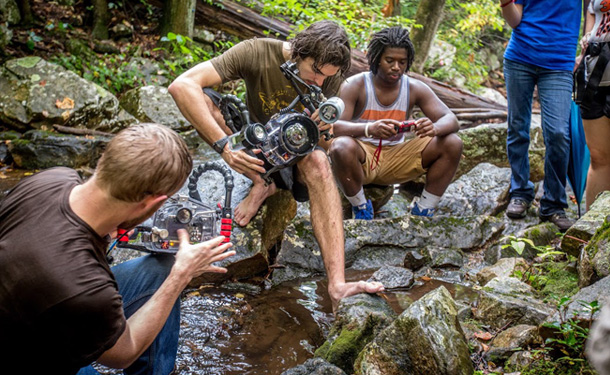Striking photos taken by an Eastern Mennonite University professor and his students of a rarely seen, endangered salamander supported citizen lobbying that may have influenced a U.S. Forest Service decision to reject a proposed gas pipeline across the salamanders’ fragile, limited habitat.
“My students and I were very involved in the public awareness campaign about the Cow Knob Salamander,” said photography professor Steven David Johnson, who chairs the Department of Visual and Communication Arts at EMU. “This campaign was spearheaded by a constellation of dedicated conservation nonprofits and advocacy groups in the region.”
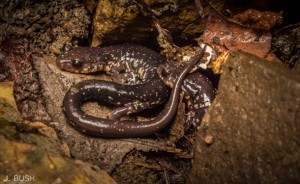
Partners who worked most closely with Johnson’s classes included Friends of Shenandoah Mountain, Virginia Wilderness Committee, Wild Virginia and the Dominion Pipeline Monitoring Coalition.
The salamander photos emerged from a class in conservation photography launched by Johnson several years ago. He sought to encourage students to “think about broader ecosystems, the environment, human culture and how they relate to the natural world, as well as about helping to protect nature.”
Johnson’s own professional work has also received attention. [To see more photos and learn more about Johnson, visit his website.]
Proposed pipeline to cross wild regions
In the fall of 2014 and 2015, Johnson’s class took photos of the George Washington National Forest and nearby areas. The images were utilized to support a half-dozen citizens’ groups opposed to the Atlantic Coast Pipeline, a proposal backed by four large utility companies. In a new pipeline more than 500 miles long, the natural gas would traverse the George Washington National Forest and Monongahela National Forest, in addition to other public and private properties in mostly rural areas of Virginia and West Virginia.
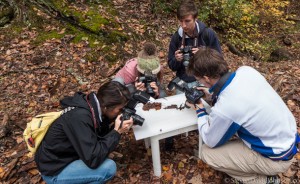
“The proposed pipeline will cross the central Allegheny Highlands, the Blue Ridge Mountains, and the adjacent valleys. It will cut through 30 miles of national forest and cross numerous rivers, streams, and wetlands,” says the website of Dominion Pipeline Monitoring Coalition, for which senior Jonathan Bush did aerial photographic surveying. “This area represents the heart of the remaining wild landscape in the eastern United States, and it is a major biodiversity refugium that can only increase in rarity and importance.”
By the coalition’s description, “the proposed pipeline will be 42 inches in diameter, requiring excavation of an 8- to 12-foot-deep trench and the bulldozing of a 125-foot-wide construction corridor straight up and down multiple steep-sided forested mountains.
“It will require construction of heavy-duty transport roads and staging areas for large earth-moving equipment and pipeline assembly. It will require blasting through bedrock, and excavation through streams and wetlands. It will require construction across unstable and hydrologically sensitive karst terrain.
“Pipeline construction on this scale, across this type of steep, well-watered, forested mountain landscape, is unprecedented,” concludes the coalition on its website.
Photographing wildlife and landscapes
Johnson and his students did not limit themselves to documenting the rare Cow Knob Salamanders, which live in the path of the proposed pipeline on and near Shenandoah Mountain. They also photographed pristine streams, verdant farmland, and breathtaking views that would be lost with pipeline construction and maintenance.
Their salamander photos, however, were the ones that seemed to have the most impact, given that they were published widely by the news media and on civic action websites across Virginia. The potential negative impact on these salamanders and the Cheat Mountain Salamanders, plus on West Virginia northern flying squirrels and ecosystem restoration areas, was cited in the Jan. 19 letter from U.S. Forest Service administrators to the Atlantic Coast Pipeline, LLC.
The commission is deliberating whether to approve proposals to construct several pipelines for moving Marcellus shale gas from western West Virginia to Virginia and the southeast. These pipelines would be the largest ever built in this region, and all routes proposed thus far would impinge on national forest land.
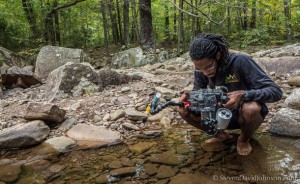
The Forest Service letter referred to natural resources of “irreplaceable character” on Shenandoah Mountain, Cheat Mountain and Back Allegheny Mountain that would need to be circumvented by any pipelines.
Students contributed to publicity efforts
“I’m very proud of the student involvement in this work – surveying, hiking, mapmaking, land and aerial photographing, and writing,” said Johnson. “It’s impossible to know exactly how much the public campaign played in the final Forest Service decision, but I have to believe the amount of publicity surrounding this little amphibian helped provide political support for this move.”
Lynn Cameron, vice president of the Virginia Wilderness Committee and past president of the Virginia Wilderness Committee, has been with the latter group since it began 10 years ago. Cameron calls the partnership between her group and Johnson’s class “mutually beneficial.” Johnson serves with Cameron on the board of the Virginia Wilderness Committee.
“Being able to show the beauty and biodiversity of the area, along with its water and recreational resources, through the images provided by EMU’s students really helps our efforts,” she says.
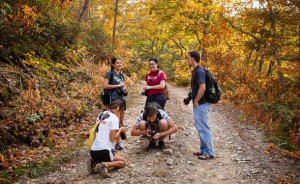
The George Washington-Jefferson National Forest receives more than 2 million visits annually, most often for hiking, fishing and picnicking, by Forest Service estimates. Access to this forest is as close as 10 miles (20 minutes by car) west of EMU’s campus.
All nine students in the fall 2014 Conservation Photography took class field trips that involved photographing landscapes and biodiversity along the proposed pipeline route: Jonathan Bush, Malika Davis, Londen Wheeler, Emma King, Ryan Keiner, Chris Lehman, Meghan Good, Amber Davis and Jonathan Drescher-Lehman. These students also divided into three small groups, two of which worked specifically on the pipeline (their images can be seen here: http://conservationphotoclass2014.virginiajournal.org).
Cameron recalls that Wheeler was the first to see and photograph the Cow Knob Salamander. Then Bush, Davis and King returned to the area and found some of these salamanders on their own. “I was with them and remember being amazed that they could actually find rare salamanders on a field trip in mid-October, which is at the end of their active season,” said Cameron. “Normally, these salamanders can be found on warm, damp nights. The students found them at mid-day during a dry spell. It was just unbelievable.”
Collectively, the students emerged with some remarkable images which have been used in publications by Wild Virginia and the Virginia Native Plant Society, among others.
In the fall 2015 Conservation Photo class, four students focused on the pipeline project, but their photos centered on farmland and private property: Curtis Handy, Rachel Schrock, Azariah Cox, and Macson McGuigan. McGuigan also worked on a joint project with his GIS class to make maps related to threatened species in the pipeline route area.
